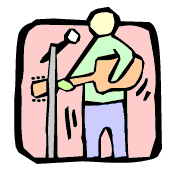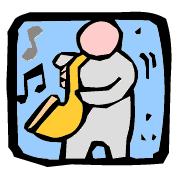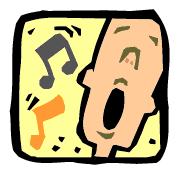(Down - Up - Top - Jazclass Links)
MN 2 - Main Lesson Topics
The Music Notation Course consists of 16 lessons and includes over 50 pages of exercises and songs. All lessons are in webstyle (html) format, and look the same as the Jazclass lessons online.
The Music Notation Course is distributed on CD-ROM, suitable for both PC and Macintosh computers.
Simply copy and paste the 'Music Notation' folder from the CD onto your computer, open the access file in the folder with your web browser (without going online), and all lessons are at your fingertips.
The Course contains numerous midi file play-a-long demos so that you can hear exactly how each exercise and song should sound.
There is also a very extensive Subject Index for easy reference.
The main lesson topics are :
- Lesson 1 - The Piano Keyboard
Subjects : Early History - Note Letter names - The Keyboard
- Lesson 2 - The Treble Clef
Subjects : The Great Staff - Clefs - The Treble Clef Staff
- Lesson 3 - Intervals (1)
Subjects : More notes on the Treble Clef - Intervals
- Lesson 4 - The Bass Clef
Subjects : Bass Clef Staff - The Piano Staff
- Lesson 5 - The C Clef
Subjects : More notes on the Bass Clef staff - The C Clef
- Lesson 6 - Note Length
Subjects : Note Length - Note Stem Positions - Bar lines - Time Signature - Tapping the beats
- Lesson 7 - Leger Lines
Subjects : Leger Lines - Rests - Minim Rest Positions
- Lesson 8 - Dotted Minims
Subjects : Dotted Minims - Rhythm Patterns - Ties - Repeat Signs
- Lesson 9 - Accidentals
Subjects : Tones & Semitones - Sharps & Flats - Naturals - Chromatic scale
- Lesson 10 - Quavers
Subjects : Quavers - Tapping the Beats - Grouping Quavers - Staccatos
- Lesson 11 - Key Signatures
Subjects : C major scale - F & G major scales - Key Signatures - Dotted Crotchets
- Lesson 12 - Intervals (2)
Subjects : Major scale intervals - Syncopation - Reading Syncopation - D Major scale - Anacrusis
- Lesson 13 - Triplets Quavers
Subjects : Triplet quavers - Swing quavers - Slurs - Tenutos - Accents
- Lesson 14 - Compound Time
Subjects : Compound Time - Altering Intervals - Intervals Qualities - Identifying Intervals
- Lesson 15 - Semiquavers
Subjects : Semiquavers - Semiquaver Rhythms - Dynamics - Tempos
- Lesson 16 - Triplet Crotchets
Subjects : Triplet crotchets - Major and Minor keys - Scales Practice - Ornaments
(Down - Up - Top - Jazclass Links)
MN 3 - About the Music Notation Course
Music notation defines three essential aspects.
- the pitch of a note
this defines the melody and harmony part of a song
- the length of a note
this defines the rhythm of the song
- the expression of the music (articulation, loudness, tempo, etc.)
The first five lessons of the Music Notation Course focus on learning to read the various note pitches.
The Music Notation Course will also familiarise you with the keyboard.
A basic understanding of the keyboard is enormously useful. It provides a visual pattern of musical elements such as scales and chords. This makes understanding and memorising these elements much easier.
 From Lesson 6 onwards the various note lengths and rhythms are introduced.
Initially you will read music one note at a time, like individual letters of a word.
From Lesson 6 onwards the various note lengths and rhythms are introduced.
Initially you will read music one note at a time, like individual letters of a word.
Gradually you become able to read several notes together as a rhythmic entity over one or two bars.
All exercises of the Course are provided in two versions, one version with, and the other without bar lines.
Always start with the exercise version without bar lines and draw the bar lines in yourself.
This way you will quickly learn to count the beats in each bar and also become familiar with the various rhythmic patterns that make up a full bar.
Check your effort with the exercise version with bar lines. Use that version also for reading and playing the exercise.
From lesson 10 onwards various forms of expression and other musical enhancements are introduced.
(Down - Up - Top - Jazclass Links)
MN 4 - Midi files for Transposing instruments
 The same written note on a score, for example 'Middle C', has a different pitch when played on a piano or on a trumpet or on an alto saxophone.
The same written note on a score, for example 'Middle C', has a different pitch when played on a piano or on a trumpet or on an alto saxophone.
Only the C played on the piano is the true C concert pitch.
The trumpet and alto sax are transposing instruments.
To match the C played on the trumpet the pianist must play a concert pitch Bb. The trumpet is therefore called a Bb instrument.
To match the C played on the alto sax the pianist must play a concert pitch Eb. The alto saxophone is therefore an Eb instrument.
Here are the three main groups of instruments.
- C instruments (with Concert pitch)
Piano, bass, guitar, flute, violin, trombone, voice, accordion, recorder, oboe
- Bb instruments
Trumpet, flugelhorn, clarinet, bass clarinet, soprano saxophone, tenor saxophone
- Eb instruments
Alto saxophone, baritone saxophone, alto clarinet
This course includes separate midi files for all exercises and songs for each of the three instrument groups.
If you play the keyboard use the C-instr. midi files. If you play the trumpet use the Bb-instr. midi files. If you play the alto sax use the Eb-instr. midi files.
(Down - Up - Top - Jazclass Links)
MN 5 - Learn to understand what you read
Compare the following two sentences.
- Ik begrijp hier niets van.
- I don't understand anything of this.
Unless you are a Dutchman you will find the second line much easier to read than the first one. Why ? Because you can understand what you are reading.
 |
The same applies to reading music.
Understanding elements of music, such as intervals, scales, chords and chord progression makes reading music a lot easier, and also much more interesting.This Course explains intervals and also deals with some of the scales and chords, but I recommend you learn more about music theory by combining the Music Notation Course with the Jazz Theory Course. This will greatly enhance many of your music skills, including music reading.
Prices - Orders
|
( Up - Top - Links)
Copyright © 2004 Michael Furstner. All rights reserved.